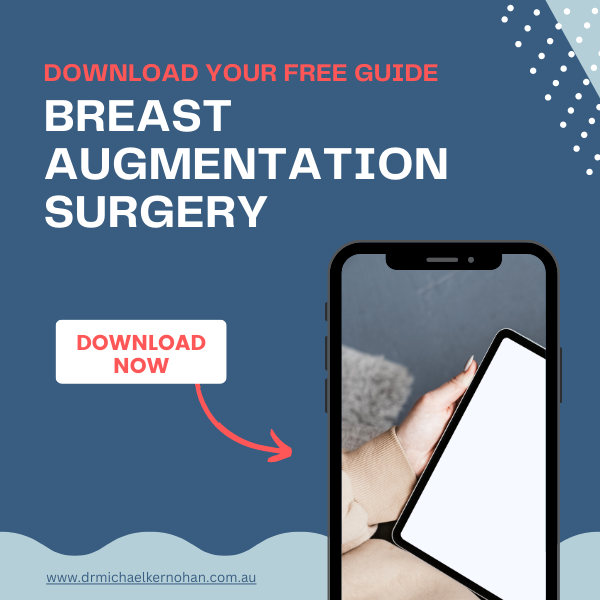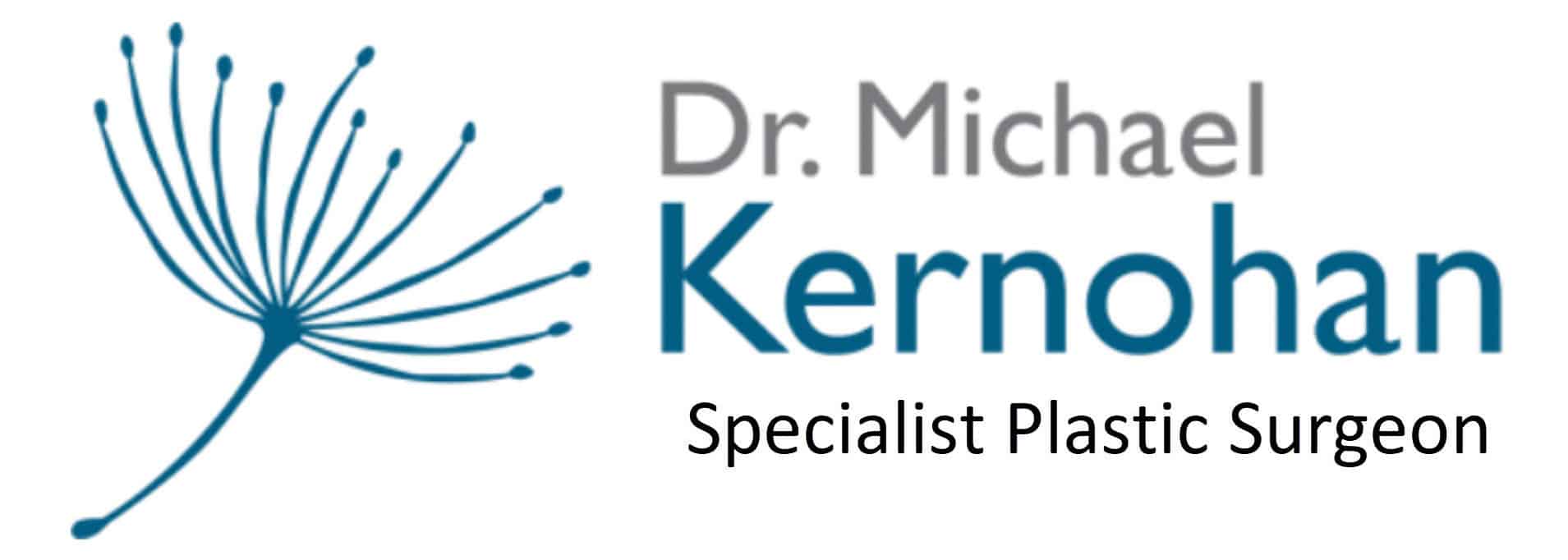What Is the Best Treatment for Sagging Breasts?
This condition is known as breast ptosis. If your breasts have become saggy, loose and have lost their perkiness, you are dealing with breast ptosis.
If you experience drooping breasts, your nipples will also start pointing downwards. Women go through a lot of physical and physiological changes in their lifetime; breastfeeding, pregnancy, and weight fluctuations. All of which can contribute to breasts sagginess.
Dr Michael Kernohan has years of experience in treating breast ptosis. He offers plenty of options to fix droopy breasts such as breast augmentation, lift, and reduction or sometimes a combination of these procedures.
CLICK to Download Dr Michael Kernohan Cosmetic Breast Surgery Guide

What is Breast Ptosis?
Breast Ptosis is a medical term that is used to describe sagging or drooping breasts. This occurs when your breasts hang lower than their normal position on the chest wall. The condition can be attributed to skin laxity, loss of breast volume, and other reasons. Your breasts are made up of glandular tissue, breast fat, and an intricate network of connective tissues that hold your breasts in place. Think of these connective tissues as a web of tight and very fine cords that run through the breasts to give them a firm shape. Over time, the ligaments become weak and stretched out which can cause your breasts to droop and lose their firmness, eventually leading to breast ptosis.
Causes of Breast Ptosis and Saggy Breasts
Ageing is one of the key factors when it comes to breast sagginess; however, it is not the only cause of breast ptosis. Some women might experience drooping of breasts in their 20s while others experience it post-menopause. A lot of factors come into play when it comes to deflated and droopy breasts.
Some of the causes of breast ptosis can include:
- Gravity – gravity might be to blame for your saggy breasts. It is one of the key factors that lead to breast ptosis – especially for large or heavy breasts. Wearing a good bra may help prevent this.
- Breast Size – it is a common observation that larger breasts sag earlier and the changes are more noticeable as compared to someone with smaller breasts. The larger your breasts are, the more the chances of gravity affecting them sooner in life. It applies to women who have naturally large breasts or are overweight and obese
- Weight Fluctuations – sudden weight loss or weight gain can stretch out your skin and ligaments, leading to breast sagging. See Options for Drooping Breasts after Weight Loss.
- Smoking – studies indicate that smoking plays havoc on skin elasticity and contributes to the drooping of breasts
- Pregnancy – the hormonal changes in your body can make your breasts look bigger. This can stretch your skin and causes your breasts to eventually start sagging
- Genetics – your genes play a very important role in determining how elastic your skin is, how firm your boobs are, and how much sagging they will experience over time. People with lax skin experience more severe breast ptosis
- Age – every woman will reach a point in her life when her breasts will become droopy. This is natural and happens as our skin and ligaments stretch. Unfortunately, there isn’t a way to prevent age-related sagging
Does Breast Feeding cause Saggy Breasts?
Some people think that breastfeeding is one of the key contributors to breast sagging. However, there aren’t any concrete studies to back this claim. By the time you give birth, your breasts will grow and develop to accommodate milk production post-childbirth. Once you begin weaning, involution begins which restores your pre-pregnancy boobs. Your milk ducts will shrink and your breast tissue will become smaller. The skin however might not retract on the new contour of the breasts in some cases, which causes sagging and deflated breasts.
Measurement of Breast Ptosis
There are multiple degrees of sagging breasts. Plastic surgeons typically use the Regnault classification of breast ptosis to classify your condition. The classification takes into account the location of the nipple, your inframammary crease (IMF) and lower breast pole. This crease is located right underneath your breasts. The lower the nipple is, the more severe the breast ptosis is.
Here is the Regnault classification:
- Grade I: Your nipple is at the level of the inframammary crease and you have minor ptosis.
- Grade II: Your nipple is below the level of the inframammary crease but above your lower breast pole. It is called Moderate Ptosis.
- Grade III: Your nipple is below the inframammary crease level and on the lower breast pole. It is called Severe Ptosis.
- Pseudoptosis: Your nipples are at a normal position but there is little to no upper pole fullness and the lower pole hangs down below the inframammary crease.
- Parenchymal maldistribution: The lower pole looks deflated and the inframammary crease is positioned too high on the chest wall. The nipple and areola are facing down.
How to Correct Saggy Breasts with Surgery
Dr Michael Kernohan offers a range of customised surgical procedures to fix sagging breasts. The procedures aim to restore the normal position of the breasts and nipples, tighten your skin and help pump up the volume of deflated breasts.
1. Mastopexy or Breast Lift
This is a good choice for you if your breasts are sagging due to stretched skin but have enough breast tissue and adequate volume. During the procedure, an incision will be made around the nipple that might extend to the lower breast pole. The excess skin will be removed and your nipples will be repositioned higher. The skin is then pulled together to help you achieve perky and firm boobs. Different surgeons offer a Lollipop-shaped incision or the Anchor-shaped incision for a Breast lift.
2. Breast Augmentation (Implants)
Breast augmentation alone can be a good solution when it comes to treating sagging breasts in women. Adding implants to your breasts in certain cases is enough to push your nipples back to the normal position. During the surgery, Dr Kernohan will create a periareolar or an inframammary incision. Then, a pocket will be created inside your breasts for the insertion of implants. The result can be perkier, larger breasts that outline your cleavage and gives you the fullness of the upper pole. This solution only works for minor breast sagginess and patients with good quality skin as the added weight of the implants may cause sagging some years later.
3. Breast Lift with Implants
In some cases, a combination of breast augmentation and lift is used to get the desired results. It is ideal for women who have sagging and deflated breasts. If your breast tissue has shrunk and your skin is stretched, this can be the perfect option for you. The procedure will involve removing the excess skin, repositioning of nipples and implant insertion to help restore a full and perky appearance.
4. Breast Reduction
If you have naturally large breasts and are dealing with breast sagging, you might see better results with a breast reduction which offers a lifting effect. During the surgery, excess tissue will be removed to minimise the size of your breasts along with the repositioning of the nipples to a higher position. It can give you perky boobs, but, more than this, the breasts will be more proportionate to the rest of your body.
If you have decided to say goodbye to your sagging breasts, schedule an appointment with Dr Kernohan for a consultation. Dr Kernohan will ask about your expectations from the surgery and design a plan that will help you reach your aesthetic goals.
Preventing Breasts Sagging: Is It Possible?
Unfortunately, there isn’t any way to prevent breast ptosis completely. There are a few things that you can do to delay ptosis or prevent extreme sagging. The following suggestions might help:
1. Maintain a Healthy Posture
The wrong posture can do more harm than you think. Sitting in a bent posture will exacerbate the impact of gravity on your breasts. So, try to sit and stand straight to offer natural support to your breasts.
2. Avoid Weight Fluctuations
Losing or gaining a lot of weight in a short amount of time can stretch your skin and lead to skin sagging. As your weight changes, so does your skin. Try to maintain a healthy weight and avoid highly restrictive diets.
3. Stay Hydrated
Drinking water is essential to keep your skin healthy and hydrated. Make sure you are always hydrated so that your skin is able to maintain its elasticity. Cut out on caffeinated beverages and drink at least 8 to 10 glasses of water a day.
4. Avoid Smoking
Smoking is not only bad for your health but also responsible for premature skin ageing and loss of elasticity. In fact, it is one of the major contributors to sagging breasts.
Breast Ptosis – Medicare or Health Insurance Coverage
If you are looking for a treatment for sagging breasts you might want to know about Australian Medicare and Health Insurance Coverage. Breast Lift might be covered partially by Medicare if you are dealing with moderate to severe breast ptosis post-pregnancy. You must meet the strict Medicare criteria.
Find out more details about Medicare item numbers and plastic surgery prices.
FAQs about Saggy Breasts and Breast Surgery
Here is a list of frequently asked questions we get regarding Breast Ptosis & Breast Surgery:
Will breast lift surgery leave a scar?
- Yes, it is a surgical procedure and you will end up with a scar. The placement and size of the scar are based on the extent of sagging. The scar is usually well hidden around the nipple or in the inframammary crease, under the breasts. Over time, your scars will fade and become less visible. You can also choose scar minimisation options once you are fully healed.
Does wearing a bra prevent the saggy breasts?
- There aren’t any solid research studies to show that wearing a bra can or cannot prevent sagging breasts. Certain experts claim that a bra can help reduce the tension in your ligaments and prevent them from stretching. Some others believe that leaving your breast to move freely is supposed to strengthen the ligaments and prevent sagging. Nobody knows just yet!
Is there a way to reverse breast sagging without surgery?
- Unfortunately, there isn’t. The only effective way to treat breast sagginess is the right surgical procedure.
Are the results of breast lift permanent?
- No. The longevity of the results greatly depends on your breasts, your lifestyle, and the elasticity of the skin. In most cases, the results will last for quite a few years if you follow the recommendations of the plastic surgeon and avoid weight fluctuations.
Further Reading about Breast Procedures for Saggy Breasts
- Read Dr Kernohan’s Breast Lift Surgery Page
- Read Dr Kernohan’s Breast Augmentation Surgery Page
- Read Dr Kernohan’s Breast Reduction Surgery Page
- Read Dr Kernohan’s Breast Lift with Implants Surgery Page
- Read Dr Kernohan’s blog about Breast Lift-Mastopexy Scar Treatment, Healing and Fading
- Read Dr Kernohan’s blog Will Medicare Cover My Breast Lift Surgery?





